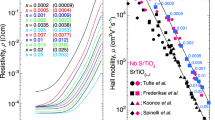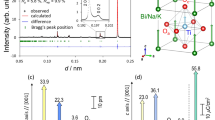Abstract
On the basis of successful first-principles predictions of new functional ferroelectric materials, a number of new ferroelectrics have been experimentally discovered. Using trilinear coupling of two types of octahedron rotation, hybrid improper ferroelectricity has been theoretically predicted in ordered perovskites and the Ruddlesden–Popper compounds (Ca3Ti2O7, Ca3Mn2O7 and (Ca/Sr/Ba)3(Sn/Zr/Ge)2O7). However, the ferroelectricity of these compounds has never been experimentally confirmed and even their polar nature has been under debate. Here we provide the first experimental demonstration of room-temperature switchable polarization in bulk crystals of Ca3Ti2O7, as well as Sr-doped Ca3Ti2O7. Furthermore, (Ca, Sr)3Ti2O7 is found to exhibit an intriguing ferroelectric domain structure resulting from orthorhombic twins and (switchable) planar polarization. The planar domain structure accompanies abundant charged domain walls with conducting head-to-head and insulating tail-to-tail configurations, which exhibit a conduction difference of two orders of magnitude. These discoveries provide new research opportunities, not only for new stable ferroelectrics of Ruddlesden–Popper compounds, but also for meandering conducting domain walls formed by planar polarization.
This is a preview of subscription content, access via your institution
Access options
Subscribe to this journal
Receive 12 print issues and online access
$259.00 per year
only $21.58 per issue
Buy this article
- Purchase on Springer Link
- Instant access to full article PDF
Prices may be subject to local taxes which are calculated during checkout




Similar content being viewed by others
References
Ad-hoc interagency Group on Advanced Materials, Materials Genome Initiative for Global Competitiveness;www.whitehouse.gov/sites/default/files/microsites/ostp/materials_genome_initiative-final.pdf (2011).
Curtarolo, S. et al. The high-throughput highway to computational materials design. Nature Mater. 12, 191–201 (2013).
Fennie, C. J. & Rabe, K. M. Magnetic and electric phase control in epitaxial EuTiO3 from first principles. Phys. Rev. Lett. 97, 267602 (2006).
Fennie, C. Ferroelectrically induced weak ferromagnetism by design. Phys. Rev. Lett. 100, 167203 (2008).
Bousquet, E. et al. Improper ferroelectricity in perovskite oxide artificial superlattices. Nature 452, 732–736 (2008).
Birol, T., Benedek, N. A. & Fennie, C. J. Interface control of emergent ferroic order in Ruddlesden–Popper Srn+1TinO3n+1 . Phys. Rev. Lett. 107, 257602 (2011).
Roy, A., Bennett, J. W., Rabe, K. M. & Vanderbilt, D. Half-Heusler semiconductors as piezoelectrics. Phys. Rev. Lett. 109, 037602 (2012).
Varga, T. et al. Coexistence of weak ferromagnetism and ferroelectricity in the high pressure LiNbO3-type phase of FeTiO3 . Phys. Rev. Lett. 103, 047601 (2009).
Lee, J. H. et al. A strong ferroelectric ferromagnet created by means of spin–lattice coupling. Nature 466, 954–958 (2010).
Lee, C. H. et al. Exploiting dimensionality and defect mitigation to create tunable microwave dielectrics. Nature 502, 532–536 (2013).
Biegalski, M. D. et al. Relaxor ferroelectricity in strained epitaxial SrTiO3 thin films on DyScO3 substrates. Appl. Phys. Lett. 88, 192907 (2006).
Pertsev, N., Tagantsev, A. & Setter, N. Phase transitions and strain-induced ferroelectricity in SrTiO3 epitaxial thin films. Phys. Rev. B 61, R825–R829 (2000).
Haeni, J. H. et al. Room-temperature ferroelectricity in strained SrTiO3 . Nature 430, 758–761 (2004).
Cheong, S. W. & Mostovoy, M. Multiferroics: A magnetic twist for ferroelectricity. Nature Mater. 6, 13–20 (2007).
Benedek, N. A. & Fennie, C. J. Hybrid improper ferroelectricity: A mechanism for controllable polarization–magnetization coupling. Phys. Rev. Lett. 106, 107204 (2011).
Benedek, N. A., Mulder, A. T. & Fennie, C. J. Polar octahedral rotations: A path to new multifunctional materials. J. Solid State Chem. 195, 11–20 (2012).
Mulder, A. T., Benedek, N. A., Rondinelli, J. M. & Fennie, C. J. Turning ABO3 antiferroelectrics into ferroelectrics: Design rules for practical rotation-driven ferroelectricity in double perovskites and A3B2O7 Ruddlesden–Popper compounds. Adv. Funct. Mater. 23, 4810–4820 (2013).
Cohen, R. & Krakauer, H. Lattice dynamics and origin of ferroelectricity in BaTiO3: Linearized-augmented-plane-wave total-energy calculations. Phys. Rev. B 42, 6416–6423 (1990).
Waghmare, U. V. & Rabe, K. M. Ab initio statistical mechanics of the ferroelectric phase transition in PbTiO3 . Phys. Rev. B 55, 6161–6173 (1997).
Kumagai, Y. & Spaldin, N. A. Structural domain walls in polar hexagonal manganites. Nature Commun. 4, 1540 (2013).
Zhu, W. et al. Electrically induced decrease of magnetization in Ca3Mn2O7 . Appl. Phys. Lett. 101, 192407 (2012).
Green, M. A., Prassides, K., Day, P. & Neumann, D. A. Structure of the n = 2 and n = ∞ member of the Ruddlesden–Popper series, Srn+1SnnO3n+1 . Int. J. Inorg. Mater. 2, 35–41 (2000).
Lobanov, M. V. et al. Crystal and magnetic structure of the Ca3Mn2O7 Ruddlesden–Popper phase: Neutron and synchrotron x-ray diffraction study. J. Phys. Condens. Matter 16, 5339–5348 (2004).
Glazer, A. M. The classification of tilted octahedra in perovskites. Acta Crystallogr. B 28, 3384–3392 (1972).
Elcombe, M. M. et al. Structure determinations for Ca3Ti2O7, Ca4Ti3O10, Ca3.6Sr0.4Ti3O10 and a refinement of Sr3Ti2O7 . Acta Crystallogr. B 47, 305–314 (1991).
Battle, P. D. et al. Neutron diffraction study of the structural and electronic properties of Sr2HoMn2O7 and Sr2YMn2O7 . Chem. Mater. 9, 3136–3143 (1997).
Cahn, R. W. Twinned crystals. Adv. Phys. 3, 363–445 (1956).
Tanaka, M. & Honjo, G. Electron optical studies of barium titanate single crystal films. J. Phys. Soc. Jpn 19, 954–970 (1964).
Randall, C. A., Barber, D. J. & Whatmore, R. W. Ferroelectric domain configurations in a modified-PZT ceramic. J. Mater. Sci. 22, 925–931 (1987).
Zanolli, Z., Wojdeł, J. C., Íñiguez, J. & Ghosez, P. Electric control of the magnetization in BiFeO3/LaFeO3 superlattices. Phys. Rev. B 88, 060102 (2013).
Harris, A. B. Symmetry analysis for the Ruddlesden–Popper systems Ca3Mn2O7 and Ca3Ti2O7 . Phys. Rev. B 84, 064116 (2011).
Jo, J. Y. et al. Coercive fields in ultrathin BaTiO3 capacitors. Appl. Phys. Lett. 89, 232909 (2006).
Wang, J. et al. Epitaxial BiFeO3 multiferroic thin film heterostructures. Science 299, 1719–1722 (2003).
Meier, D. et al. Anisotropic conductance at improper ferroelectric domain walls. Nature Mater. 11, 284–288 (2012).
Wu, W. et al. Conduction of topologically protected charged ferroelectric domain walls. Phys. Rev. Lett. 108, 077203 (2012).
Sluka, T., Tagantsev, A. K., Bednyakov, P. & Setter, N. Free-electron gas at charged domain walls in insulating BaTiO3 . Nature Commun. 4, 1808 (2013).
Chishima, Y., Noguchi, Y., Kitanaka, Y. & Miyayama, M. Defect control for polarization switching in BiFeO3 single crystals. IEEE Trans. Ultrason. Ferroelectr. Freq. Control 57, 2233–2236 (2010).
Seidel, J. et al. Conduction at domain walls in oxide multiferroics. Nature Mater. 8, 229–234 (2009).
Frederikse, H. & Hosler, W. Hall mobility in SrTiO3 . Phys. Rev. 161, 822–827 (1967).
Guyonnet, J., Gaponenko, I., Gariglio, S. & Paruch, P. Conduction at domain walls in insulating Pb(Zr0.2Ti0.8)O3 thin films. Adv. Mater. 23, 5377–5382 (2011).
Schröder, M. et al. Conducting domain walls in lithium niobate single crystals. Adv. Funct. Mater. 22, 3936–3944 (2012).
Scott, J. F. et al. Radiation effects on ferroelectric thin-film memories: Retention failure mechanisms. J. Appl. Phys. 66, 1444–1453 (1989).
Acknowledgements
The work at Rutgers University was supported by the Gordon and Betty Moore Foundation’s EPiQS Initiative through Grant GBMF4413 to the Rutgers Center for Emergent Materials, and that at Postech by the Max Planck POSTECH/KOREA Research Initiative Program (Grant No. 2011-0031558) through the NRF of Korea funded by MEST.
Author information
Authors and Affiliations
Contributions
Y.S.O. carried out P(E), IP-PFM, IP-PFM before/after poling, cAFM, I–V measurements and statistical analysis, and conceived the hypothetical model. X.L. synthesized single crystals and performed XRD. F-T.H. performed the structure refinement. Y.S.O. and S-W.C. analysed the data and wrote the manuscript. S-W.C. initiated and supervised the research.
Corresponding author
Ethics declarations
Competing interests
The authors declare no competing financial interests.
Supplementary information
Supplementary Information
Supplementary Information (PDF 970 kb)
Rights and permissions
About this article
Cite this article
Oh, Y., Luo, X., Huang, FT. et al. Experimental demonstration of hybrid improper ferroelectricity and the presence of abundant charged walls in (Ca,Sr)3Ti2O7 crystals. Nature Mater 14, 407–413 (2015). https://doi.org/10.1038/nmat4168
Received:
Accepted:
Published:
Issue Date:
DOI: https://doi.org/10.1038/nmat4168
This article is cited by
-
Electrical detection and modulation of magnetism in a Dy-based ferroelectric single-molecule magnet
Nature Communications (2023)
-
Novel air-electrode materials for low-cost inert-supported solid oxide cells: investigation of materials compatibility during co-sintering
Journal of Materials Science (2023)
-
Double-Bilayer polar nanoregions and Mn antisites in (Ca, Sr)3Mn2O7
Nature Communications (2022)
-
Direct observation of geometric and sliding ferroelectricity in an amphidynamic crystal
Nature Materials (2022)
-
Biferroelectricity of a homochiral organic molecule in both solid crystal and liquid crystal phases
Nature Communications (2022)



